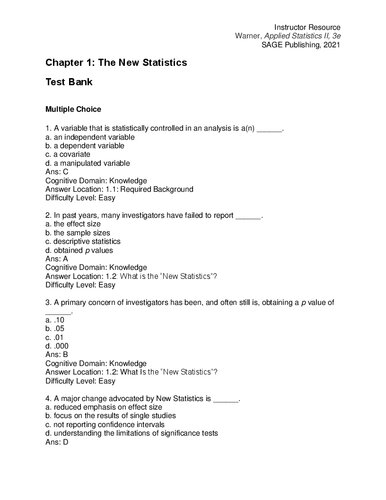Applied Statistics II Multivariable and Multivariate Techniques Test Bank 3rd Edition by Rebecca Warner ISBN 9781544398723 1544398727
$50.00 Original price was: $50.00.$25.00Current price is: $25.00.
Applied Statistics II Multivariable and Multivariate Techniques Test Bank 3rd Edition by Rebecca Warner – Ebook PDF Instant Download/Delivery: 9781544398723 ,1544398727
Full download Applied Statistics II Multivariable and Multivariate Techniques Test Bank 3rd Edition after payment
Product details:
ISBN 10: 1544398727
ISBN 13: 9781544398723
Author: Rebecca Warner
Applied Statistics II Multivariable and Multivariate Techniques Test Bank 3rd Edition Table of contents:
Chapter 1 • The New Statistics
1.1 Required Background
1.2 What Is the “New Statistics”?
1.3 Common Misinterpretations of p Values
1.4 Problems With NHST Logic
1.5 Common Misuses of NHST
1.5.1 Violations of Assumptions
1.5.2 Violations of Rules for Use of NHST
1.5.3 Ignoring Artifacts and Data Problems That Bias p Values
1.5.4 Summary
1.6 The Replication Crisis
1.7 Some Proposed Remedies for Problems With NHST
1.7.1 Bayesian Statistics
1.7.2 Replace α = .05 with α = .005
1.7.3 Less Emphasis on NHST
1.8 Review of Confidence Intervals
1.8.1 Review: Setting Up CIs
1.8.2 Interpretation of CIs
1.8.3 Graphing CIs
1.8.4 Understanding Error Bar Graphs
1.8.5 Why Report CIs Instead of, or in Addition to, Significance Tests?
1.9 Effect Size
1.9.1 Generalizations About Effect Sizes
1.9.2 Test Statistics Depend on Effect Size Combined With Sample Size
1.9.3 Using Effect Size to Evaluate Theoretical Significance
1.9.4 Use of Effect Size to Evaluate Practical or Clinical Importance (or Significance)
1.9.5 Uses for Effect Sizes
1.10 Brief Introduction to Meta-Analysis
1.10.1 Information Needed for Meta-Analysis
1.10.2 Goals of Meta-Analysis
1.10.3 Graphic Summaries of Meta-Analysis
1.11 Recommendations for Better Research and Analysis
1.11.1 Recommendations for Research Design and Data Analysis
1.11.2 Recommendations for Authors
1.11.3 Recommendations for Journal Editors and Reviewers
1.11.4 Recommendations for Teachers of Research Methods and Statistics
1.11.5 Recommendations About Institutional Incentives and Norms
1.12 Summary
Chapter 2 • Advanced Data Screening: Outliers and Missing Values
2.1 Introduction
2.2 Variable Names and File Management
2.2.1 Case Identification Numbers
2.2.2 Codes for Missing Values
2.2.3 Keeping Track of Files
2.2.4 Use Different Variable Names to Keep Track of Modifications
2.2.5 Save SPSS Syntax
2.3 Sources of Bias
2.4 Screening Sample Data
2.4.1 Data Screening Need in All Situations
2.4.2 Data Screening for Comparison of Group Means
2.4.3 Data Screening for Correlation and Regression
2.5 Possible Remedy for Skewness: Nonlinear Data Transformations
2.6 Identification of Outliers
2.6.1 Univariate Outliers
2.6.2 Bivariate and Multivariate Outliers
2.7 Handling Outliers
2.7.1 Use Different Analyses: Nonparametric or Robust Methods
2.7.2 Handling Univariate Outliers
2.7.3 Handling Bivariate and Multivariate Outliers
2.8 Testing Linearity Assumption
2.9 Evaluation of Other Assumptions Specific to Analyses
2.10 Describing Amount of Missing Data
2.10.1 Why Missing Values Create Problems
2.10.2 Assessing Amount of Missingness Using SPSS Base
2.10.3 Decisions Based on Amount of Missing Data
2.10.4 Assessment of Amount of Missingness Using SPSS Missing Values Add-On
2.11 How Missing Data Arise
2.12 Patterns in Missing Data
2.12.1 Type A and Type B Missingness
2.12.2 MCAR, MAR, and MNAR Missingness
2.12.3 Detection of Type A Missingness
2.12.4 Detection of Type B Missingness
2.13 Empirical Example: Detecting Type A Missingness
2.14 Possible Remedies for Missing Data
2.15 Empirical Example: Multiple Imputation to Replace Missing Values
2.16 Data Screening Checklist
2.17 Reporting Guidelines
2.18 Summary
Appendix 2A: Brief Note About Zero-Inflated Binomial or Poisson Regression
Chapter 3 • Statistical Control: What Can Happen When You Add a Third Variable?
3.1 What Is Statistical Control?
3.2 First Research Example: Controlling for a Categorical X2 Variable
3.3 Assumptions for Partial Correlation Between X1 and Y, Controlling for X2
3.4 Notation for Partial Correlation
3.5 Understanding Partial Correlation: Use of Bivariate Regressions to Remove Variance Predictable by X2 From Both X1 and Y
3.6 Partial Correlation Makes No Sense if There Is an X1 × X2 Interaction
3.7 Computation of Partial r From Bivariate Pearson Correlations
3.8 Significance Tests, Confidence Intervals, and Statistical Power for Partial Correlations
3.8.1 Statistical Significance of Partial r
3.8.2 Confidence Intervals for Partial r
3.8.3 Effect Size, Statistical Power, and Sample Size Guidelines for Partial r
3.9 Comparing Outcomes for rY1.2 and rY1
3.10 Introduction to Path Models
3.11 Possible Paths Among X1, Y, and X2
3.12 One Possible Model: X1 and Y Are Not Related Whether You Control for X2 or Not
3.13 Possible Model: Correlation Between X1 and Y Is the Same Whether X2 Is Statistically Controlled or Not ( X2 Is Irrelevant to the X1, Y Relationship)
3.14 When You Control for X2, Correlation Between X1 and Y Drops to Zero
3.14.1 X1 and X2 Are Completely Redundant Predictors of Y
3.14.2 X1, Y Correlation Is Spurious
3.14.3 X1, Y Association Is Completely Mediated by X2
3.14.4 True Nature of the X1, Y Association (Their Lack of Association) Is “Suppressed” by X2
3.14.5 Empirical Results Cannot Determine Choice Among These Explanations
3.15 When You Control for X2, the Correlation Between X1 and Y Becomes Smaller (But Does Not Drop to Zero or Change Sign)
3.16 Some Forms of Suppression: When You Control for X2, r1Y.2 Becomes Larger Than r1Y or Opposite in Sign to r1Y
3.16.1 Classical Suppression: Error Variance in Predictor Variable X1 Is “Removed” by Control Variable X2
3.16.2 X1 and X2 Both Become Stronger Predictors of Y When BothAre Included in Analysis
3.16.3 Sign of X1 as a Predictor of Y Reverses When Controlling for X2
3.17 “None of the Above”
3.18 Results Section
3.19 Summary
Chapter 4 • Regression Analysis and Statistical Control
4.1 Introduction
4.2 Hypothetical Research Example
4.3 Graphic Representation of Regression Plane
4.4 Semipartial (or “Part”) Correlation
4.5 Partition of Variance in Y in Regression With Two Predictors
4.6 Assumptions for Regression With Two Predictors
4.7 Formulas for Regression With Two Predictors
4.7.1 Computation of Standard-Score Beta Coefficients
4.7.2 Formulas for Raw-Score (b) Coefficients
4.7.3 Formulas for Multiple R and Multiple R2
4.7.4 Test of Significance for Overall Regression: F Test for H0: R = 0
4.7.5 Test of Significance for Each Individual Predictor: t Test for H0: bi = 0
4.7.6 Confidence Interval for Each b Slope Coefficient
4.8 SPSS Regression
4.9 Conceptual Basis: Factors That Affect the Magnitude and Sign of β and b Coefficients in Multiple Regression With Two Predictors
4.10 Tracing Rules for Path Models
4.11 Comparison of Equations for β, b, pr, and sr
4.12 Nature of Predictive Relationships
4.13 Effect Size Information in Regression With Two Predictors
4.13.1 Effect Size for Overall Model
4.13.2 Effect Size for Individual Predictor Variables
4.14 Statistical Power
4.15 Issues in Planning a Study
4.15.1 Sample Size
4.15.2 Selection of Predictor and/or Control Variables
4.15.3 Collinearity (Correlation) Between Predictors
4.15.4 Ranges of Scores
4.16 Results
4.17 Summary
Chapter 5 • Multiple Regression With Multiple Predictors
5.1 Research Questions
5.2 Empirical Example
5.3 Screening for Violations of Assumptions
5.4 Issues in Planning a Study
5.5 Computation of Regression Coefficients With k Predictor Variables
5.6 Methods of Entry for Predictor Variables
5.6.1 Standard or Simultaneous Method of Entry
5.6.2 Sequential or Hierarchical (User-Determined) Method of Entry
5.6.3 Statistical (Data-Driven) Order of Entry
5.7 Variance Partitioning in Standard Regression Versus Hierarchical and Statistical Regression
5.8 Significance Test for an Overall Regression Model
5.9 Significance Tests for Individual Predictors in Multiple Regression
5.10 Effect Size
5.10.1 Effect Size for Overall Regression (Multiple R)
5.10.2 Effect Size for Individual Predictor Variables (sr2)
5.11 Changes in F and R as Additional Predictors Are Added to a Model in Sequential or Statistical Regression
5.12 Statistical Power
5.13 Nature of the Relationship Between Each X Predictor and Y (Controlling for Other Predictors)
5.14 Assessment of Multivariate Outliers in Regression
5.15 SPSS Examples
5.15.1 SPSS Menu Selections, Output, and Results for Standard Regression
5.15.2 SPSS Menu Selections, Output, and Results for Sequential Regression
5.15.3 SPSS Menu Selections, Output, and Results for Statistical Regression
5.16 Summary
Appendix 5A: Use of Matrix Algebra to Estimate Regression Coefficientsfor Multiple Predictors
5.A.1 Matrix Addition and Subtraction
5.A.2 Matrix Multiplication
5.A.3 Matrix Inverse
5.A.4 Matrix Transpose
5.A.5 Determinant
5.A.6 Using the Raw-Score Data Matrices for X and Y toCalculate b Coefficients
Appendix 5B: Tables for Wilkinson and Dallal (1981) Test ofSignificance of Multiple R2 in Forward Statistical Regression
Appendix 5C: Confidence Interval for R2
Chapter 6 • Dummy Predictor Variables in Multiple Regression
6.1 What Dummy Variables Are and When They Are Used
6.2 Empirical Example
6.3 Screening for Violations of Assumptions
6.4 Issues in Planning a Study
6.5 Parameter Estimates and Significance Tests for Regressions with Dummy Predictor Variables
6.6 Group Mean Comparisons Using One-Way Between-S ANOVA
6.6.1 Sex Differences in Mean Salary
6.6.2 College Differences in Mean Salary
6.7 Three Methods of Coding for Dummy Variables
6.7.1 Regression With Dummy-Coded Dummy Predictor Variables
6.7.2 Regression With Effect-Coded Dummy Predictor Variables
6.7.3 Orthogonal Coding of Dummy Predictor Variables
6.8 Regression Models That Include Both Dummy and Quantitative Predictor Variables
6.9 Effect Size and Statistical Power
6.10 Nature of the Relationship and/or Follow-Up Tests
6.11 Results
6.12 Summary
Chapter 7 • Moderation: Interaction in Multiple Regression
7.1 Terminology
7.2 Interaction Between Two Categorical Predictors: Factorial ANOVA
7.3 Interaction Between One Categorical and One Quantitative Predictor
7.4 Preliminary Data Screening: One Categorical and One Quantitative Predictor
7.5 Scatterplot for Preliminary Assessment of Possible Interaction Between Categorical and Quantitative Predictor
7.6 Regression to Assess Statistical Significance of Interaction Between One Categorical and One Quantitative Predictor
7.7 Interaction Analysis With More Than Three Categories
7.8 Example With Different Data: Significant Sex-by-Years Interaction
7.9 Follow-Up: Analysis of Simple Main Effects
7.10 Interaction Between Two Quantitative Predictors
7.11 SPSS Example of Interaction Between Two Quantitative Predictors
7.12 Results for Interaction of Age and Habits as Predictors of Symptoms
7.13 Graphing Interaction for Two Quantitative Predictors
7.14 Results Section for Interaction of Two Quantitative Predictors
7.15 Additional Issues and Summary
Appendix 7A: Graphing Interactions Between QuantitativeVariables “by Hand”
Chapter 8 • Analysis of Covariance
8.1 Research Situations for Analysis of Covariance
8.2 Empirical Example
8.3 Screening for Violations of Assumptions
8.4 Variance Partitioning in ANCOVA
8.5 Issues in Planning a Study
8.6 Formulas for ANCOVA
8.7 Computation of Adjusted Effects and Adjusted Y * Means
8.8 Conceptual Basis: Factors That Affect the Magnitude of SSAadj and SSresidual and the Pattern of Adjusted Group Means
8.9 Effect Size
8.10 Statistical Power
8.11 Nature of the Relationship and Follow-Up Tests: Information to Include in the “Results” Section
8.12 SPSS Analysis and Model Results
8.12.1 Preliminary Data Screening
8.12.2 Assessment of Assumption of No Treatment-by-Covariate Interaction
8.12.3 Conduct Final ANCOVA Without Interaction Term Between Treatment and Covariate
8.13 Additional Discussion of ANCOVA Results
8.14 Summary
Appendix 8A: Alternative Methods for the Analysis of Pretest–Posttest Data
8.A.1 Potential Problems With Gain or Change Scores
Chapter 9 • Mediation
9.1 Definition of Mediation
9.1.1 Path Model Notation
9.1.2 Circumstances in Which Mediation May Be a Reasonable Hypothesis
9.2 Hypothetical Research Example
9.3 Limitations of “Causal” Models
9.3.1 Reasons Why Some Path Coefficients May Be Not Statistically Significant
9.3.2 Possible Interpretations for Statistically Significant Paths
9.4 Questions in a Mediation Analysis
9.5 Issues in Designing a Mediation Analysis Study
9.5.1 Types of Variables in Mediation Analysis
9.5.2 Temporal Precedence or Sequence of Variables in Mediation Studies
9.5.3 Time Lags Between Variables
9.6 Assumptions in Mediation Analysis and Preliminary Data Screening
9.7 Path Coefficient Estimation
9.8 Conceptual Issues: Assessment of Direct Versus Indirect Paths
9.8.1 The Mediated or Indirect Path: ab
9.8.2 Mediated and Direct Path as Partition of Total Effect
9.8.3 Magnitude of Mediated Effect
9.9 Evaluating Statistical Significance
9.9.1 Causal-Steps Approach
9.9.2 Joint Significance Test
9.9.3 Sobel Test of H0: ab = 0
9.9.4 Bootstrapped Confidence Interval for ab
9.10 Effect Size Information
9.11 Sample Size and Statistical Power
9.12 Additional Examples of Mediation Models
9.12.1 Multiple Mediating Variables
9.12.2 Multiple-Step Mediated Paths
9.12.3 Mediated Moderation and Moderated Mediation
9.13 Note About Use of Structural Equation Modeling Programs to Test Mediation Models
9.14 Results Section
9.15 Summary
Chapter 10 • Discriminant Analysis
10.1 Research Situations and Research Questions
10.2 Introduction to Empirical Example
10.3 Screening for Violations of Assumptions
10.4 Issues in Planning a Study
10.5 Equations for Discriminant Analysis
10.6 Conceptual Basis: Factors That Affect the Magnitude of Wilks’ Λ
10.7 Effect Size
10.8 Statistical Power and Sample Size Recommendations
10.9 Follow-Up Tests to Assess What Pattern of Scores Best Differentiates Groups
10.10 Results
10.11 One-Way ANOVA on Scores on Discriminant Functions
10.12 Summary
Appendix 10A: The Eigenvalue/Eigenvector Problem
Appendix 10B: Additional Equations for Discriminant Analysis
Chapter 11 • Multivariate Analysis of Variance
11.1 Research Situations and Research Questions
11.2 First Research Example: One-Way MANOVA
11.3 Why Include Multiple Outcome Measures?
11.4 Equivalence of MANOVA and DA
11.5 The General Linear Model
11.6 Assumptions and Data Screening
11.7 Issues in Planning a Study
11.8 Conceptual Basis of MANOVA
11.9 Multivariate Test Statistics
11.10 Factors That Influence the Magnitude of Wilks’ Λ
11.11 Effect Size for MANOVA
11.12 Statistical Power and Sample Size Decisions
11.13 One-Way MANOVA: Career Group Data
11.14 2 × 3 Factorial MANOVA: Career Group Data
11.14.1 Follow-Up Tests for Significant Main Effects
11.14.2 Follow-Up Tests for Nature of Interaction
11.14.3 Further Discussion of Problems With This 2 × 3 Factorial Example
11.15 Significant Interaction in a 3 × 6 MANOVA
11.16 Comparison of Univariate and Multivariate Follow-Up Analyses
11.17 Summary
Chapter 12 • Exploratory Factor Analysis
12.1 Research Situations
12.2 Path Model for Factor Analysis
12.3 Factor Analysis as a Method of Data Reduction
12.4 Introduction of Empirical Example
12.5 Screening for Violations of Assumptions
12.6 Issues in Planning a Factor-Analytic Study
12.7 Computation of Factor Loadings
12.8 Steps in the Computation of PC and Factor Analysis
12.8.1 Computation of the Correlation Matrix R
12.8.2 Computation of the Initial Factor Loading Matrix A
12.8.3 Limiting the Number of Components or Factors
12.8.4 Rotation of Factors
12.8.5 Naming or Labeling Components or Factors
12.9 Analysis 1: PC Analysis of Three Items Retaining All Three Components
12.9.1 Finding the Communality for Each Item on the Basis of All Three Components
12.9.2 Variance Reproduced by Each of the Three Components
12.9.3 Reproduction of Correlations From Loadings on All Three Components
12.10 Analysis 2: PC Analysis of Three Items Retaining Only the First Component
12.10.1 Communality for Each Item on the Basis of One Component
12.10.2 Variance Reproduced by the First Component
12.10.3 Cannot Reproduce Correlations Perfectly From Loadings on Only One Component
12.11 PC Versus PAF
12.12 Analysis 3: PAF of Nine Items, Two Factors Retained, No Rotation
12.12.1 Communality for Each Item on the Basis of Two Retained Factors
12.12.2 Variance Reproduced by Two Retained Factors
12.12.3 Partial Reproduction of Correlations From Loadings on Only Two Factors
12.13 Geometric Representation of Factor Rotation
12.14 Factor Analysis as Two Sets of Multiple Regressions
12.14.1 Construction of Factor Scores for Each Individual (F1, F2, etc.)From Individual Item z Scores
12.14.2 Prediction of z Scores for Individual Participant (zXi)From Participant Scores on Factors (F1, F2, etc.)
12.15 Analysis 4: PAF With Varimax Rotation
12.15.1 Variance Reproduced by Each Factor at Three Stages in the Analysis
12.15.2 Rotated Factor Loadings
12.15.3 Example of a Reverse-Scored Item
12.16 Questions to Address in the Interpretation of Factor Analysis
12.17 Results Section for Analysis 4: PAF With Varimax Rotation
12.18 Factor Scores Versus Unit-Weighted Composites
12.19 Summary of Issues in Factor Analysis
Appendix 12A: The Matrix Algebra of Factor Analysis
Appendix 12B: A Brief Introduction to Latent Variables in SEM
Chapter 13 • Reliability, Validity, and Multiple-Item Scales
13.1 Assessment of Measurement Quality
13.1.1 Reliability
13.1.2 Validity
13.1.3 Sensitivity
13.1.4 Bias
13.2 Cost and Invasiveness of Measurements
13.2.1 Cost
13.2.2 Invasiveness
13.2.3 Reactivity of Measurement
13.3 Empirical Examples of Reliability Assessment
13.3.1 Definition of Reliability
13.3.2 Test-Retest Reliability Assessment for a Quantitative Variable
13.3.3 Interobserver Reliability Assessment for Scores on a Categorical Variable
13.4 Concepts From Classical Measurement Theory
13.4.1 Reliability as Partition of Variance
13.4.2 Attenuation of Correlations Due to Unreliability of Measurement
13.5 Use of Multiple-Item Measures to Improve Measurement Reliability
13.6 Computation of Summated Scales
13.6.1 Assumption: All Items Measure the Same Construct and Are Scored in the Same Direction
13.6.2 Initial (Raw) Scores Assigned to Individual Responses
13.6.3 Variable Naming, Particularly for Reverse-Worded Questions
13.6.4 Factor Analysis to Assess Dimensionality of a Set of Items
13.6.5 Recoding Scores for Reverse-Worded Items
13.6.6 Summing Scores Across Items to Compute a Total Score: Handling Missing Data
13.6.7 Comparison of Unit-Weighted Summed Scores Versus Saved Factor Scores
13.7 Assessment of Internal Homogeneity for Multiple-Item Measures: Cronbach’s Alpha Reliability Coefficient
13.7.1 Conceptual Basis of Cronbach’s Alpha
13.7.2 Empirical Example: Cronbach’s Alpha for Five Selected CES-D Items
13.7.3 Improving Cronbach’s Alpha by Dropping a “Poor” Item
13.7.4 Improving Cronbach’s Alpha by Increasing the Number of Items
13.7.5 Other Methods of Reliability Assessment for Multiple-Item Measures
13.8 Validity Assessment
13.8.1 Content and Face Validity
13.8.2 Criterion-Oriented Validity
13.8.3 Construct Validity: Summary
13.9 Typical Scale Development Process
13.9.1 Generating and Modifying the Pool of Items or Measures
13.9.2 Administer the Survey to Participants
13.9.3 Factor-Analyze Items to Assess the Number and Nature of Latent Variables or Constructs
13.9.4 Development of Summated Scales
13.9.5 Assess Scale Reliability
13.9.6 Assess Scale Validity
13.9.7 Iterative Process
13.9.8 Create the Final Scale
13.10 A Brief Note About Modern Measurement Theories
13.11 Reporting Reliability
13.12 Summary
Appendix 13A: The CES-D
Appendix 13B: Web Resources on Psychological Measurement
Chapter 14 • More About Repeated Measures
14.1 Introduction
14.2 Review of Assumptions for Repeated-Measures ANOVA
14.3 First Example: Heart Rate and Social Stress
14.4 Test for Participant-by-Time or Participant-by-Treatment Interaction
14.5 One-Way Repeated-Measures Results for Heart Rate and Social Stress Data
14.6 Testing the Sphericity Assumption
14.7 MANOVA for Repeated Measures
14.8 Results for Heart Rate and Social Stress Analysis Using MANOVA
14.9 Doubly Multivariate Repeated Measures
14.10 Mixed-Model ANOVA: Between-S and Within-S Factors
14.10.1 Mixed-Model ANOVA for Heart Rate and Stress Study
14.10.2 Interaction of Intervention Type and Times of Assessment in Hypothetical Experiment With Follow-Up
14.10.3 First Follow-Up: Simple Main Effect (Across Time) for Each Intervention
14.10.4 Second Follow-Up: Comparisons of Intervention Groups at the Same Points in Time
14.10.5 Comparison of Repeated-Measures ANOVA With Difference-Score and ANCOVA Approaches
14.11 Order and Sequence Effects
14.12 First Example: Order Effect as a Nuisance
14.13 Second Example: Order Effect Is of Interest
14.14 Summary and Other Complex Designs
Chapter 15 • Structural Equation Modeling With Amos: A Brief Introduction
15.1 What Is Structural Equation Modeling?
15.2 Review of Path Models
15.3 More Complex Path Models
15.4 First Example: Mediation Structural Model
15.5 Introduction to Amos
15.6 Screening and Preparing Data for SEM
15.6.1 SEM Requires Large Sample Sizes
15.6.2 Evaluating Assumptions for SEM
15.7 Specifying the Structural Equation Model (Variable Names and Paths)
15.7.1 Drawing the Model Diagram
15.7.2 Open SPSS Data File and Assign Names to Measured Variables
15.8 Specify the Analysis Properties
15.9 Running the Analysis and Examining Results
15.10 Locating Bootstrapped CI Information
15.11 Sample Results Section for Mediation Example
15.12 Selected Structural Equation Model Terminology
15.13 SEM Goodness-of-Fit Indexes
15.14 Second Example: Confirmatory Factor Analysis
15.14.1 General Characteristics of CFA
15.15 Third Example: Model With Both Measurement and Structural Components
15.16 Comparing Structural Equation Models
15.16.1 Comparison of Nested Models
15.16.2 Comparison of Non-Nested Models
15.16.3 Comparisons of Same Model Across Different Groups
15.16.4 Other Uses of SEM
15.17 Reporting SEM
15.18 Summary
Chapter 16 • Binary Logistic Regression
16.1 Research Situations
16.1.1 Types of Variables
16.1.2 Research Questions
16.1.3 Assumptions Required for Linear Regression Versus Binary Logistic Regression
16.2 First Example: Dog Ownership and Odds of Death
16.3 Conceptual Basis for Binary Logistic Regression Analysis
16.3.1 Why Ordinary Linear Regression Is Inadequate When Outcome Is Categorical
16.3.2 Modifying the Method of Analysis to Handle a Binary Categorical Outcome
16.4 Definition and Interpretation of Odds
16.5 A New Type of Dependent Variable: The Logit
16.6 Terms Involved in Binary Logistic Regression Analysis
16.6.1 Estimation of Coefficients for a Binary Logistic Regression Model
16.6.2 Assessment of Overall Goodness of Fit for a Binary Logistic Regression Model
16.6.3 Alternative Assessments of Overall Goodness of Fit
16.6.4 Information About Predictive Usefulness of Individual Predictor Variables
16.6.5 Evaluating Accuracy of Group Classification
16.7 Logistic Regression for First Example: Prediction of Death From Dog Ownership
16.7.1 SPSS Menu Selections and Dialog Boxes
16.7.2 SPSS Output
16.7.3 Results for the Study of Dog Ownership and Death
16.8 Issues in Planning and Conducting a Study
16.8.1 Preliminary Data Screening
16.8.2 Design Decisions
16.8.3 Coding Scores on Binary Variables
16.9 More Complex Models
16.10 Binary Logistic Regression for Second Example: Drug Dose and Sex as Predictors of Odds of Death
16.11 Comparison of Discriminant Analysis With Binary Logistic Regression
16.12 Summary
Chapter 17 • Additional Statistical Techniques
17.1 Introduction
17.2 A Brief History of Developments in Statistics
17.3 Survival Analysis
17.4 Cluster Analyses
17.5 Time-Series Analyses
17.5.1 Describing a Single Time Series
17.5.2 Interrupted Time Series: Evaluating Intervention Impact
17.5.3 Cycles in Time Series
17.5.4 Coordination or Interdependence Between Time Series
17.6 Poisson and Binomial Regression for Zero-Inflated Count Data
17.7 Bayes’ Theorem
17.8 Multilevel Modeling
17.9 Some Final Words
Glossary
References
Index
People also search for Applied Statistics II Multivariable and Multivariate Techniques Test Bank 3rd Edition:
what is multivariate techniques
multivariate vs multivariable
multivariable mathematics
multivariable and vector calculus
Tags:
Rebecca Warner,Statistics II,Multivariable,Multivariate Techniques
You may also like…
Uncategorized
Medicine - Others
Computers - Computer Certification & Training
Mathematics - Applied Mathematics
Uncategorized
International Debt Statistics 2017 1st Edition by World Bank 1464809941 978-1464809941
Physics - Mechanics
Mechanics II for JEE Advanced 3rd Edition by Sharma 9789353503741 9353503744
Mathematics - Mathematical Statistics
Applied and Computational Statistics 1st Edition by Sorana Bolboaca ISBN 3039281763 9783039281763












